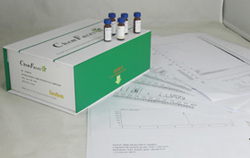Hot Products



| Catalog No. | Information |
| CFN92555 | Skimmianin Skimmianine is a new inhibitor against the Leishmania APRT enzyme, it is also a strong acetylcholinesterase (AChE) inhibitor. Skimmianine has anti-inflammatory, immunomodulatory, and leishmanicidal properties, it has a selective inhibitory effect on the 5-hydroxytryptamine-induced vasopressor responses of rats. |
| CFN97505 | Skimmin Skimmin has anti-inflammatory, and anti-cancer activities, it can significantly improve renal function and suppress the IgG deposition as well as the development of glomerular lesions in a rat model of membranous glomerulonephritis; it also can suppress diabetic nephropathy in rats effectively, and may slow down the renal fibrosis by regulating TGF-β1 signal pathway. |
| CFN98643 | Skullcapflavone I Skullcapflavone I has anti-inflammatory and anti-allergic potential, it can significantly inhibit LPS stimulated NO and PGE(2) release in J774A.1 macrophages and inhibit LPS induced IL-6 production in a concentration dependent manner. Skullcapflavone I selectively induces apoptosis in T-HSC/Cl-6 cells via caspase-3 and caspase-9 activation. |
| CFN92216 | Skullcapflavone II Skullcapflavone II is a flavonoid derived from Scutellaria baicalensis, a widely used herbal medicine in anti-inflammatory and anticancer therapy in Korea. Skullcapflavone II may have therapeutic potential for the treatment of allergic asthma. |
| CFN99509 | Sodium Aescinate Sodium aescinate has immunity enhancing,anti-inflammatory and antioxidant activities, may effectively control and improve wound healing in diabetic rats. It has obvious antiangiogenic effect, the initiation of angiogenesis and proliferation of endothelial cell are inhibited and the secretion of VEGF is also decreased. Sodium aescinate can protect the lung injury induced by intestinal ischemia/reperfusion (I/R), which may be mediated by inhibiting lipid peroxidation, upregulating Bcl-2 gene protein expression, improving the ratio of Bcl-2/ Bax to inhibit lung apoptosis.;it also can protect against liver injury induced by methyl parathion. |
| CFN99163 | Sodium Danshensu Sodium danshensu (SDSS), the sodium salt of danshensu (DSS), has the neuroprotective effect against cerebral I/R injury, and the potential mechanism might to inhibition of apoptosis through activating the PI3K/Akt signal pathway. SDSS has a protective effect against the genotoxicity of cigarette smoke,it shows a biphasic effects on vessel tension, while low dosage of sodium danshensu produces small contraction possibly through transient enhancement of Ca(2+) influx, high dosage produces significant vasodilation mainly through promoting the opening of non-selective K(+) channels and small-conductance calcium-sensitive K(+) channels in the vascular smooth muscle cells. |
| CFN90975 | Sodium houttuyfonate Sodium houttuyfonate is anti-pseudomonas agents, inhibits virulence related motility of Pseudomonas aeruginosa.It also inhibits biofilm formation and alginate biosynthesis-associated gene expression in a clinical strain of Pseudomonas aeruginosa in vitro. Sodium houttuyfonate has anti-inflammatory activity, inhibits inflammation by blocking the MAPKs/NF-κB signaling pathways in bovine endometrial epithelial cells. |
| CFN94333 | Sodium Saccharin |
| CFN80241 | Sodium taurochenodeoxycholate Sodium taurochenodeoxycholate can increase glucose-induced insulin secretion and stimulate the electrical activity of β-cells and enhance cytosolic Ca(2+) concentration ([Ca(2+)](c)). |
| CFN91741 | Sodium taurocholate Sodium taurocholate has marked bioactive effects such as an inhibitory potential against hepatic artery ligation induced biliary damage by upregulation of VEGF-A expression. Sodium taurocholate has immunoregulation effect. IC50 & Target:Microbial Metabolite; Human Endogenous Metabolite |